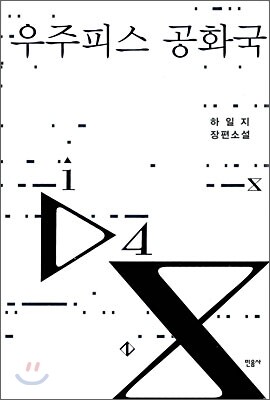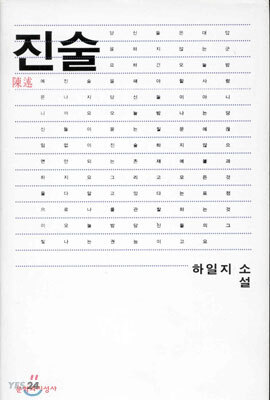Haïlji (born 1955) is a modern South Korean writer.
Life
Haïlji was born in 1955 and graduated from Chung-Ang University with a degree in creative writing. He then taught high school until 1983, when he left South Korea for France. In France he earned an M.A. from Poitiers University and a Ph.D. from University of Limoges. He returned to South Korea in 1989. His career as an author began with the publication of his controversial novel, Gyeongmajang ganeun gil (경마장 가는 길 The Road to the Racetrack) in 1990. Many of his works have been made into movies or plays, including director Jang Sun-woo's adaptation of The Road to the Racetrack. As such, Ha is also credited as an important contributor to the development of modern Korean cinema.
Writing
Haïlji's first book, Gyeongmajang ganeun gil, brought him immediate fame as well as a share of notoriety. The novel centers on an intellectual who has just returned from France and portrays the gradual crumbling of his world—both internal and external—as he struggles with the hypocritical standards and conservative values of Korean society.
In the next three years, Haïlji published four novels—Gyeongmajangeun negeorieseo (경마장은 네거리에서 Racetrack at the Crossroads), Gyeongmajangeul wihayeo (경마장을 위하여 For Racetracks), Gyeongmajangui orinamu (경마장의 오리나무 An Alder Tree at the Racetracks), and Gyeongmajangeseo saenggin il (경마장에서 생긴 일 What Happened at the Racetracks)—all of which shocked the Korean literary world with their unique and innovative approach towards contradictions in life. Critical assessment of his works swung from one extreme to another, and Haïlji became embroiled in a series of debates with conservative literary critics—now widely known as the "Racetrack Controversy." His subsequent works, such as Jinsul (진술 The Testimony) or Ujupiseu gonghwaguk (우주피스 공화국 The Republic of Užupis) are characterized by a fantastic or dreamy atmosphere and have helped to secure him a readership of avid admirers. In 1993, he published a ciné-roman entitled Mano kabinaui chueok (마노 카비나의 추억 Mano Cabina Remembered).
Haïlji is also active as a poet, writing not only in his native Korean but also in English and French. A volume of his English poems, Blue Meditation of the Clocks, was published in the U.S. in 1994, and his French poems were published in Paris under the title Les Hirondelles dans mon tiroir in 2003. He may be the only writer in Korea who has written and published his works in many different languages.
Haïlji (1955-), graduado en Escritura Creativa por la Universidad Jung-ang, enseñó en la escuela superior hasta que viajó a Francia en 1983 para ampliar sus estudios. Aprobado su M.A. en la Universidad de Poitiers, obtuvo su doctorado por la Universidad de Limoges antes de retornar a Corea en 1989. Un año más tarde, publicó su novela El camino hacia el hipódromo, una obra polémica, que inmediatamente le brindó tanto el reconocimiento como la celebridad. La trama de la novela se centra en un intelectual que acaba de volver de Francia y que debe enfrentarse al derrumbe gradual de su mundo, tanto el interior como el externo, que se genera durante su lucha contra las normas y los valores conservadores en el seno de la sociedad coreana. Durante los tres años siguientes, Haïlji publicó cuatro novelas –El hipódromo en el cruce de caminos, Para hipódromos, Un árbol de aliso en el hipódromo y Controversia en el hipódromo –, cuyos argumentos produjeron un escándalo en los círculos literarios coreanos por su singular e innovadora manera de afrontar las contradicciones de la vida. La evaluación crítica de sus obras varía de un extremo al otro, y Haïlji, al final, ha asumido su compromiso al enfrentarse a los críticos literarios conservadores en una serie de debates, que se han hecho famosos bajo la denominación de la Controversia en el hipódromo. Sus obras posteriores se caracterizan por su atmósfera onírica o fantástica y le han asegurado un círculo de lectores compuesto por ávidos admiradores.
Le premier livre de Ha est La route vers les hippodromes qui lui a apporté une célébrité immédiate3. Le roman évoque un intellectuel qui vient de rentrer de France et dépeint l'effondrement progressif de son monde, à la fois interne et externe comme il a du mal avec les normes hypocrites et les valeurs conservatrices de la société coréenne1. Les trois années suivantes, Ha publie quatre romans. À ce titre, il est aussi connu comme un romancier ne publiant que des romans et non des nouvelles, format très prisé en Corée du Sud4. Durant cette période, il écrit Au carrefour des hippodromes (Gyeongmajang negeorieseo), Pour les hippodromes (Gyeongmajang-eul wihayeo), Un aulne dans l'hippodrome (Gyeongmajang-ui orinamu), Ce qui est arrivé dans l'hippodrome (Gyeongmajang-eseo saeng-gin il). Tous ses romans ont relativement choqué dans le monde littéraire coréen. Les évaluations critiques de ses œuvres varient d'un extrême à l'autre, et Ha s'est retrouvé impliqué dans une série de débats entre les conservateurs littéraires et les critiques, épisode maintenant largement connu comme la « controverse de l'hippodrome ». Ses travaux ultérieurs sont caractérisés par une atmosphère fantastique voire onirique et ont contribué à lui assurer un lectorat d'admirateurs impatients1. En 1993, il a publié un « ciné-roman » intitulé Se souvenir de Mano Cabine (Mano Cabina-ui chu-eok). Il est également actif en tant que poète. Un volume de ses poèmes en anglais est paru en 1994 aux États-Unis Méditation bleue sur les horloges. En 2003, ses poèmes en français ont été publiés sous le titre Les Hirondelles dans mon tiroir. Il est peut être le seul écrivain en Corée qui a écrit et publié ses œuvres dans plusieurs langues
Haïlji, dessen bürgerlicher Name Im Chong-ju ist, wurde am 3. Mai 1955 in Kyŏngju in der Provinz Nord-Kyŏngsang geboren. Er studierte an der Chung-Ang Universität Kreatives Schreiben. Von 1980 bis 1983 war er als Gymnasiallehrer tätig. tätig. Im Jahr 1983 ging er nach Frankreich, um sich weiterzubilden. An der Universität Poitiers machte er seinen Master in Französischer Literatur. Im gleichen Fach promovierte er danach an der Universität Limoges. 1989 kehrte er nach Korea zurück.[2] Er ist als Professor für Kreatives Schreiben an der Dongduk Women’s University tätig. Seinen ersten Roman Die Straße zur Rennbahn (경마장 가는길) veröffentlichte Haïlji im Jahr 1990. Das umstrittene Werk brachte ihm schnelle Anerkennung, jedoch nicht nur im positiven Sinne. Der Roman handelt von einem koreanischen Intellektuellen, der mehrere Jahre in Frankreich lebte, sich dabei an die westliche Kultur gewöhnte und nach Südkorea zurückkehrte. Es wird beschrieben, wie schwer es ihm fällt sich wieder in der koreanischen Gesellschaft einzufinden und dass er eine kritische Haltung gegenüber deren Verhaltenskodex und Sitten entwickelt. In den darauffolgenden drei Jahren veröffentlichte Haïlji weitere vier Romane: Für die Rennbahn, Rennbahn an einer Kreuzung, Erlenbaum an der Rennbahn und Was auf der Rennbahn passierte. Alle erschütterten die koreanische Literaturwelt mit ihrem einzigartigen, innovativen Ansatz, Widersprüche im koreanischen Alltag darzustellen. Konservative Kritikerkreise führten eine Serie heftiger Debatten, die als "Rennbahn-Kontroverse" bekannt sind. Haïljis spätere Werke sind unter anderem charakterisiert durch eine träumerische Atmosphäre und sicherten ihm eine begeisterte Lesergemeinde. Im Jahr 2009 wurde Republik Užupis veröffentlicht, ein fiktiver Roman über Litauen. Haïlji besuchte Litauen bereits mehrfach und ließ sich v.a. von der Hauptstadt inspirieren. 2013 wurde das Buch ins Litauische übersetzt. Die besondere Verbindung des Autors zu Litauen zeigt sich auch in der langen Freundschaft mit dem litauischen Lyriker Kornelijus Platelis.[4] Viele von Haïljis Werken wurden für Filme oder Theaterstücke verwendet. So wird dem Schriftsteller auch eine wichtige Rolle für die Entwicklung des modernen koreanischen Kinos zugesprochen. Weiterhin ist Haïlji im Bereich Lyrik tätig und veröffentlichte seine Werke nicht nur in Koreanisch, sondern auch in Englisch (Blue meditations of the clocks) und Französisch (Les hirondelles dans mon tiroir).
하일지(1955~)는 대한민국의 소설가다.
생애
하일지는 1955년 경상북도 경주에서 태어났다. 본명은 임종주. 중앙대학교 문예창작과 및 동 대학원 국문과를 졸업하였다. 그 후 프랑스의 푸아티에 대학교에서 석사학위를 받고, 리모주 대학원을 졸업하였다. 1990년 장편 《경마장 가는 길》을 민음사에서 출간하며 작품 활동을 시작했다. 이후 《경마장을 위하여》(1991) 등을 비롯하여 다수의 장편소설을 발표하였다.
작가는 2015년 동덕여대 문예창작과 교수로 일하던 중, 제자에 대한 성추행으로 2020년 유죄확정을 받았다.
작품 세계
하일지가 1990년에 발표한 《경마장 가는 길》은 1990년대 한국문학에서 포스트모더니즘의 시작을 알리는 작품으로 평가되었다. 이후 작가는 주로 장편소설을 창작하면서 비교적 꾸준히 작품 활동을 이어왔다. 그의 작품은 주로 후기 산업사회 이후 자본화된 사회의 문제와 억압구조 속에서 적응하지 못하는 인간의 모습이 그려져 있다. 그의 작품은 포스트 모던한 시대에 대한 사람들의 환멸과 일탈을 꿈꾸는 자아를 통해 시대가 당면하고 있는 핵심적인 현실 문제들을 새로운 소설 작법을 통해 보여주고 있다.
장편 《진술》(2000)은 주인공이 독백 형식으로 진술을 하는 과정을 담아놓은 작품이다. 처음부터 끝까지 주인공의 독백으로 이루어진 구성이 익숙하지 않지만, 진실이라고 알고 있던 것이 거짓으로 변하는 과정을 몇 차례 통과하면서 독자는 주인공의 심리에 점차 동화된다.
장편 《우주피스 공화국》(2009)은 북유럽의 설원을 배경으로, 노스탤지어의 힘에 끌려 들어가는 이야기를 담았다. 소설은 현실적인 환상, 환상적인 현실이 치밀하게 엮인 뫼비우스적 세계를 다룬다. 작가는 40대 동양인 남자를 주인공으로 삼아, 우주피스 공화국의 흔적을 발견하고 우주피스어를 사용하는 사람들을 만나지만, 모두 우주피스의 존재를 부정하는 미궁과 같은 세계에서 진실을 찾아가는 과정을 그리고 있다.
장편 《손님》(2012)은 주인공이 하원이라는 마을에서 일어난 에피소드를 담은, 유머와 위트가 넘치는 블랙코미디다. 작품은 우스꽝스러운 상황 묘사, 감칠맛 나는 대사들, 넘치는 유머와 위트로 인간의 삶을 가차 없이 폭로하고 애써 외면하려는 인간의 적나라한 모습을 그대로 보여준다.
장편 《누나》(2014)는 소년의 눈에 비친 신비로운 세계, 전설, 신화, 동화로 가득한 세계를, 설화와 구비문학의 형식을 차용하여 그려 냈다. 작가는 우리가 잃어버린 것, 기억 속에서 사라져 버린 아름다운 시절, 그 신비로운 세계를 재현해 내며, 한국인의 원형(原型)이라 할 수 있는 세계를 충실히 구현해 냈다.
주요 작품
1) 장편소설
《경마장 가는 길》, 민음사, 1990.
《경마장은 네거리에서》, 민음사, 1991.
《경마장을 위하여》, 민음사, 1991.
《경마장의 오리나무》, 민음사, 1992.
《경마장에서 생긴 일》 민음사, 1993.
《위험한 알리바이》, 세계사, 1995.
《그는 나에게 지타를 아느냐고 물었다》, 세계사, 1994.
《새》, 민음사, 1999.
《진술》, 문학과지성사, 2000.
《마노 카비나의 추억》, 민음사, 2002.
《우주피스 공화국》, 민음사, 2009.
《손님》, 민음사, 2012.
《누나》, 민음사, 2014.
2) 시집
《시계들의 푸른 명상》, 민음사, 1994.
3) 산문집
《내 서랍 속의 제비들》, 민음사, 2010.





